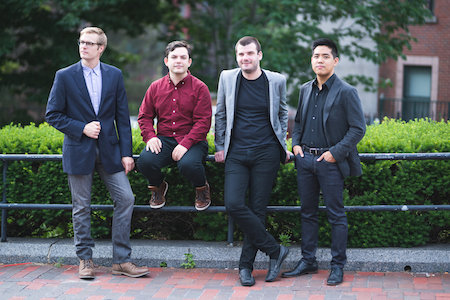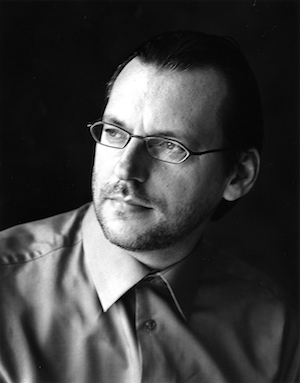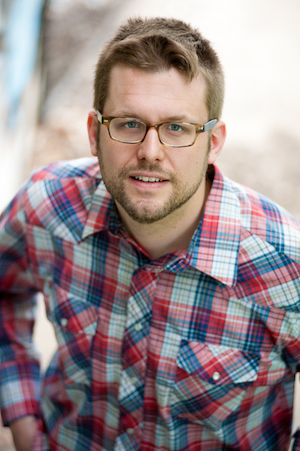by Jarrett Hoffman

Flutist Michael Avitabile, clarinetist David Dziardziel, violinist Zenas Hsu, and cellist Jesse Christesen can be heard at CSU’s Drinko Recital Hall on Monday, March 26 at 8:00 pm, after a short residence working with the university’s composition department. Then they’ll head to Cirigliano Studio Theatre on Wednesday, March 28 at 7:30 pm to perform on LCCC’s Signature Series.
Opposite Fun House on the program is Soul House (2017), a commission from composer Robert Honstein, but there’s no connection between the two Houses. “Our program sounds like something off of HGTV,” Avitabile joked. “It’s funny that the pieces turned out that way,” he said in a recent conversation from Jamaica Plain in Boston — “I’m at the very end of the Orange Line.”
Avitabile, who is also Hub’s founder and executive director, described the 10-minute Fun House as energetic and, well, fun. “The title says it all, really. We’ve been hearing so much Petrushka in this, with the bright, quartal harmonies and some crunchy, dissonant rhythmic language. Two ecstatic sections bookend the piece, and in the middle is this waltz where ideas are exchanged between two pairings — alto flute and violin in one cartoonish melody, and cello and clarinet mirroring that in true fun-house fashion.”

The ensemble has a longer history with Robert Honstein. “Rob is a dear friend of ours,” Avitabile said. “We’ve known him since Hub began several years ago.”
Honstein discusses the concept behind Soul House in his program note:
In the ancient world a ‘Soul House’ was a model home buried with the dead. Intended as a vessel for the soul to inhabit in the afterlife, often stocked with clay food, tiny furniture, and even small servant figurines, these otherworldly structures provided sustenance and comfort, a connection to loved ones, and a spiritual home as the soul moved beyond the material world.
While writing Soul House I thought about these ancient funerary objects and began to think of my own childhood home as a ‘Soul House.’ Not for my soul, but rather for memories of family and childhood…With that feeling in mind, I wrote this piece: a love letter to the house I grew up in.

Each of nine movements depicts a part of Honstein’s childhood home, “with little dramas unfolding along the way,” the composer writes. That specificity of the movements, and of the markings in the score, has allowed the ensemble to “try to get inside the memory box of Rob’s childhood, so to speak,” Avitabile said.
In the first movement, Bay Window, the flutist said, “You can imagine sunlight going through the window in that sparkly, wonderful way that a 5-year-old would find so fascinating.” Backyard is the scene of Honstein’s two siblings and their dog running around. “It’s a fugal march where all the voices chase each other.” At the end is Secret Place, “an almost Brahmsian movement that really hits hard with the nostalgia.”
In between those Houses of Fun and Soul will come The Full Range of Blue by Laura Kaminsky. Hub will play six of its eight movements.
“In light of the tumultuous political climate, we found this piece to be especially relevant,” Avitabile said. “Laura’s a brilliant composer, and her work has been given a lot of attention, mainly her opera As One about the transition of a trans person. Much of her work has social-political commentary.”
Kaminsky (above) writes that The Full Range of Blue was conceived during a summer holiday in the Canadian Rockies:
…I was struck by the range of blue encountered in the natural landscape — from the indigo-tinted lupines in the alpine meadows to the aquamarine water of the glacial lakes and waterfalls, from the slate blue of the rocky tundra to the blue-black of the star filled sky. Sitting at the shore of Eva Lake during a hiking rest stop, I sketched with crayons and filled the page with abstract color fields, using only the blue, green, and purple crayons in the box. I then wrote, “When is blue no longer blue, but becomes grey or green or purple?” I thought about issues of fluidity and humanity, about real versus perceived, and absolution versus relativism and knew, somehow, that piece would address those ideas in sound.
My challenge was to build the piece with a limited range of musical materials, and to reframe them in different ways in each of the movements so that their “blueness” was always being transformed and therefore perceived as new, although at the core remained “blue.” Small musical motives, the “blue” ideas serve not only to differentiate the movements from each other, but also to unify the work as a whole.
The compositional timeframe also proved pivotal to the work: Kaminsky wrote it between July and October of 2001 —
…in two decidedly different worlds: the world of nature and beauty and the world we now inhabit after the terror of September 11th. Writing across this great divide necessarily changed some of my original content, and I felt unable to complete the work until it addressed the aftermath…its meaning is no longer a celebration of the natural world but a lamentation on its destruction.
The ensemble hadn’t originally planned on performing The Full Range of Blue very extensively this season. “But given the current environmental issues, in addition to the slew of other political problems, we decided to reintegrate it into our repertoire.”
Avitabile (below) and I closed our conversation on the subject of food. “I grew up in the restaurants where my dad worked in Long Island,” he said. “I wanted to be a chef before I even knew what a flute was.”

As one nor’easter after another hit Boston this month, the flutist watched the snow coming down hard. Baked pasta dishes began calling to him. Thus was born this recipe:
“I roasted some butternut squash, pureed it with a healthy dosage of cream, grabbed some ground pork that I’d bought, some onions and oregano, a little bit of fresh thyme, some garlic, a little red pepper, tossed that puree together with also a very healthy amount of fontina cheese, added some semi-cooked pasta, baked it at 500 for 15-20 minutes — and it came out to be this glorious, oozing, bubbly, delightful, roasted squash pasta dish. I have so much left over, I’m going to be eating it for the next month of my life.”
Photos by Nile Scott Shots, Herbert Ascherman, Elisa Ferrari, and Rebecca Allan, respectively, the last one courtesy of Hub New Music
Published on ClevelandClassical.com March 20, 2018.
Click here for a printable copy of this article




